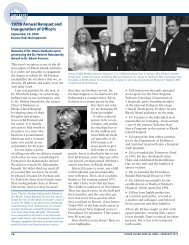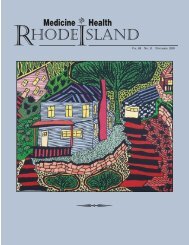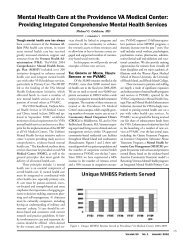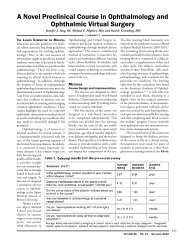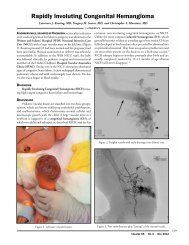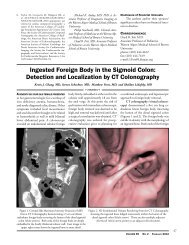Hyperuricemia & Gout - Rhode Island Medical Society
Hyperuricemia & Gout - Rhode Island Medical Society
Hyperuricemia & Gout - Rhode Island Medical Society
You also want an ePaper? Increase the reach of your titles
YUMPU automatically turns print PDFs into web optimized ePapers that Google loves.
Approach To the Treatment of <strong>Hyperuricemia</strong><br />
Despite a sound understanding of the<br />
synthetic and metabolic pathways that<br />
control serum uric acid levels, clinicians<br />
have been limited to a few urate lowering<br />
agents and one urate synthesis inhibitor<br />
since the development of allopurinol<br />
in 1956. 1 Febuxostat (Uloric) became<br />
the second urate synthesis inhibitor when<br />
the Food and Drug Administration<br />
(FDA) approved it in early 2009. The<br />
role of febuxostat in the management of<br />
hyperuricemia and gout remains to be<br />
fully determined. This review will discuss<br />
the traditional agents used for the<br />
lowering of serum uric acid and address<br />
the potential benefits febuxostat may offer<br />
in clinical practice.<br />
SOURCES OF SERUM URATE<br />
Serum uric acid accumulates from<br />
the metabolism of purine nucleic acids<br />
which are derived either from cellular<br />
breakdown or directly from foods rich<br />
in purines such as red meats, beer, shellfish,<br />
and yeast extracts. 2 Catabolism of<br />
purines is mediated through a cascade of<br />
well regulated enzymes that includes<br />
phosphoribosyl pyrophosphate synthetase<br />
(PRPS), hypoxanthine-guanine<br />
phosphoribosyltransferase (HRPT), and<br />
xanthine oxidase (XO). 3 (Figure 1) A<br />
deficiency in HRPT or PRPS over-activity<br />
results in hyperuricemic syndromes like<br />
Lesch-Nyhan and Kelley-Seegmiller, with<br />
resultant gouty arthropathy in some patients.<br />
Unlike other animal species, humans<br />
and other primates do not express<br />
uricase, the enzyme which converts uric<br />
acid into the more soluble allantoin for<br />
excretion. Uric acid is therefore the end<br />
product in human purine catabolism and<br />
is ultimately excreted in urine and also,<br />
to a lesser proportion, in the stool. Drugs<br />
that inhibit xanthine oxidase and uricosuric<br />
agents that increase renal uric acid<br />
excretion are the cornerstone of therapy<br />
for hyperuricemia.<br />
ASYMPTOMATIC HYPERURICEMIA<br />
Uric acid exceeds its solubility in extracellular<br />
spaces such as the joint or soft<br />
tissue at a concentration of 6.8 mg/dL.<br />
Uric acid precipitates as monosodium<br />
<br />
Samuel H. Poon, MD, Harald A. Hall, MD, and Bernard Zimmermann, MD<br />
urate (MSU) crystals in these compartments<br />
but for varying reasons, does not<br />
always cause an inflammatory response.<br />
The risk of having symptomatic hyperuricemia<br />
is related to the degree of serum<br />
urate elevation. In an early study, Campion<br />
et al. demonstrated that in patients<br />
with serum urate levels less than 7.0mg/<br />
dL, the annual incidence of gouty arthritis<br />
was only 0.1% as compared to 4.9%<br />
in patients with serum rate greater than<br />
9.0 mg/dL. 4 However, after five years of<br />
follow-up even patients with serum urate<br />
greater than 9.0mg/dL only had a cumulative<br />
incidence of gouty arthritis of 22%,<br />
demonstrating that a large proportion of<br />
patients with increased serum uric acid<br />
remain unaffected by gout. While the<br />
extent of hyperuricemia is correlated with<br />
a higher risk for gouty arthritis, hyperuricemia<br />
for any individual can persists for<br />
years without symptoms. Therefore,<br />
empiric treatment of asymptomatic hyperuricemia<br />
is not advised.<br />
INDICATIONS FOR<br />
TREATMENT OF<br />
HYPERURICEMIA<br />
Pharmacologic<br />
reduction of hyperuricemia<br />
is generally<br />
required in patients<br />
with symptomatic<br />
disease.<br />
Most commonly,<br />
urate lowering<br />
agents are indicated<br />
for patients with<br />
more than one episode<br />
of acute gouty<br />
arthritis, all patients<br />
with tophaceous<br />
gout and chronic<br />
gouty arthritis, and<br />
patients with uric<br />
acid renal stones.<br />
Other situations that<br />
require the use of allopurinol<br />
include<br />
hyperuricemia associated<br />
with known<br />
inherited disorders<br />
like the Lesch-Nyhan<br />
Figure 1. Purine Metabolism Pathway.<br />
and Kelley-Seegmiller syndromes, or<br />
more frequently as prophylaxis before cytolytic<br />
therapy for cancer.<br />
TREATING HYPERURICEMIA:<br />
DIETARY APPROACH AND<br />
ADJUNCTIVE THERAPY<br />
Approximately 60% of patients who<br />
have experienced acute gout arthritis experience<br />
a repeat attack within one year,<br />
based on historical data. 5 Prospective data<br />
to guide physicians are lacking, but it may<br />
be beneficial to attempt lifestyle and dietary<br />
modification rather than to commit<br />
to lifelong therapy in patients with a<br />
single attack of gout. If this fails, antihyperuricemic<br />
therapy will be necessary.<br />
Patients should be educated on dietary<br />
and lifestyle modifications that can<br />
reduce serum urate levels. These patients<br />
should attempt to reduce purine-rich<br />
foods such as red or organ meats and<br />
shellfish, and they should avoid alcohol<br />
intake, especially beer. Weight loss and<br />
XO: xanthine oxidase; HPRT: hypoxanthine-guanine phosphoribosyltransferase; APRT:<br />
adenine phosphoribosyltransferase; PRPS: phosphoribosyl pyrophosphate synthetase.<br />
AMP: adenosine monophosphate; GMP: guanosine monophosphate; IMP: inosine<br />
monophosphate; ATP: adenosine triphosphate; R5P: ribose-5-phosphate.<br />
Adapted from Kassimatis et al, J Nephrol 2005; 18: 447-451. (3)<br />
VOLUME 92 NO. 11 NOVEMBER 2009<br />
359




